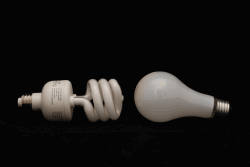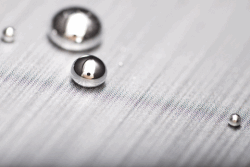Compact Fluorescent Light Bulbs: Energy-Efficient CFL Bulbs and the Environment
Compact fluorescent light bulbs are the fastest and easiest way to save money on lighting costs, but their environmental impact is mixed.
Compact fluorescent light bulbs have become something of a sensation among environmental enthusiasts, home owners who want to save money, and states trying to preserve their energy reserves. The question still remains, though: are CFLs really the most environmentally friendly solution? In this article, I will discuss both the pros and the cons of the modern love of compact fluorescent light bulbs. I will conclude that CFLs are indeed the fastest and least expensive ways to save on energy costs, but that their impact on the overall environment is not yet fully understood.
CFLs: The Basics

Homeowners are increasingly considering the environment in their lighting choices.
Compact fluorescent light bulbs produce light by exciting a mercury vapor within a glass tube. This excited vapor causes a phosphorescent coating on the tube to emit light, which is what provides the bulb’s illumination. This is the reason that fluorescent light bulbs are tube shaped. No one has really figured out how to make one spherical.
It is from their process of producing light that CFLs get both their strengths and their weaknesses. Most of the energy that goes into exciting the mercury vapor in the CFL is turned directly into light, making them highly energy efficient. On the other hand, most of the energy that goes into an incandescent light bulb turns into heat.
The presence of mercury is a source of concern in compact fluorescent light bulbs. For the most part, objects with mercury have been made illegal and taken out of the home. The increased used of CFLs represents the return of mercury into the home.
CFLs and Savings
Compact fluorescent light bulbs provide a good opportunity for savings for homeowners, since they can be easily installed with next to no disruption in overall lighting design. In fact, the main reasons that fluorescent lighting has recently become so popular is that CFLs are designed to be compatible with most household light fixtures. Basically, anywhere that you can put an incandescent bulb that can be purchased at the supermarket, you can also put a compact fluorescent light bulb.

Compact fluorescent light bulbs can significantly cut your lighting energy costs.
This means that you can literally convert all of your standard household lighting to CFLs within a single day. Any non-standard lighting might be more difficult, but there are a number of different types of CFLs available online that will fit many different types of fixtures.
A quick conversion will save you about seventy-five to eighty percent on your lighting energy costs overnight, as compact fluorescent light bulbs are four or times more efficient than standard incandescent lights. That means the portion of your energy bill that goes to lighting, usually about five to ten percent, will be cut significantly and you will save money.
From a money saving perspective, though, is this worth the price? The issue is that CFLs themselves cost significantly more money than incandescents, usually about ten dollars more per bulb. It will therefore take some time to make up for this lost money and to actually break even.
However, it should not take too long. It really depends on how much you use your lights. The more often you use them, the quicker you will make the money back. For instance, a light in the laundry room will probably take quite a while to earn back all of the money, while one in the living room will earn it back very quickly.
You should expect to break even in about six months to a year after replacing your bulbs, and since your CFL bulbs will last about five years, it represents an overall financial benefit. Since swapping your bulbs to CFLs is so easy, changing is a quick way to have energy savings.
Note that if you intend to install dimmers for your fluorescent lighting, you will incur costs that will take years to recoup. Fluorescent dimmers currently cost about two hundred dollars each for a mid-range dimmer. This will eat up most of your savings for about a decade, at least in that room of your house.
Life-Cycle Energy Use
From a global perspective, the amount of energy saved by compact fluorescent light bulbs is a poorly studied question. CFLs, like any product, have an entire life-cycle, from their production to their disposal, and every step of that journey takes more energy than it does for an incandescent light bulb.

Most CFLs will end their life-cycle in landfills or incinerated.
First, it takes more energy to produce a fluorescent light bulb than it does to produce an incandescent light bulb. A study by Gydesen and Maimann concluded that it takes almost six times more energy to produce a CFL than an incandescent light bulb.
Second, transport and storage of CFLs requires more energy than incandescent light bulbs. CFLs are heavier, but, more importantly, they are made of toxic materials and are fragile. As a result, more safety precautions must be taken when transporting and storing them. Unfortunately, no study has been done to examine the environmental impact of this storage.
Finally, CFLs are much more difficult to dispose of than incandescent light bulbs. The harmful chemicals in them, especially mercury, must be disposed of separately, and this requires a process that consumes yet more energy. Again, no comprehensive study has been done on the amount of energy used in disposing of CFLs.
Nonetheless, these processes probably do not add up to the overall savings in energy one gets from using CFLs. For instance, the same study by Gydesen and Maimann concluded that the savings in energy from using a CFL was sixty times higher than the extra cost in energy of producing it. Unless the transport, storage and disposal of CFLs costs substantially more than making them, they will still represent an overall savings.
Mercury in the Home
Most articles discussing mercury in compact fluorescent light bulbs tend to consider mercury as an environmental hazard rather than a hazard for the home. However, most home owners would consider this a mistake. Mercury in the home brings with it special dangers that need to be considered when considering purchasing compact fluorescent light bulbs.

As a liquid metal, mercury is one of nature’s more interesting elements. Unfortunately, it is also one of the more toxic.
To give you a sense of how dangerous the EPA believes that a broken CFL is, below are some of the protocols listed on their website for what you should do if you break one:
- Evacuate the room for five to ten minutes.
- Turn off your central heating or air conditioning.
- Dispose of any bedding or clothing that touched liquid mercury, lest washing it contaminate the sewage system.
- The next several times you vacuum, turn off the central heating or air conditioning.
- Et cetera.
As you can see, mercury spills in the home are very serious, and any broken light CFL in your home represents a mercury spill.
Those who try to minimize CFL breakage tend to focus on the mercury gas that is emitted when the bulb is broken, and they are correct that it reduces to safe levels after several hours. However, the liquid mercury that is also spilled can be difficult enough to remove that the EPA recommends taking precautions when vacuuming weeks after a spill.
So, you’ll need to make a decision about how comfortable you are with having mercury in your home, and whether you believe that the environmental benefits of reducing electrical consumption are worth introducing a hazardous substance. At the very least, don’t install a CFL in the garage if your son plays floor hockey there.
Mercury in the Environment
Fortunately, there have been some good studies on the effect that mercury has on the environment. Also fortunately, these studies do not simply assume that people dispose of their CFLs in the recommended way, but take into account the high number of CFLs that would likely simply be discarded. As a result, we have some idea of the amount of mercury that would be released by CFLs. Gydesen and Maimann concluded that a CFL produces 1 milligram of mercury for every million lumen hours (a “lumen hour” is the number of hours the bulb is on multiplied by its brightness in lumens).
However, there is a catch. If you use fossil fuel plants to power incandescent light bulbs, those bulbs actually produce more mercury than CFLs would. Burning fossil fuels releases mercury into the environment as energy is produced. The extra power needed to illuminate an incandescent light bulb ultimately releases more mercury into the environment than the CFL, even though the incandescent bulb itself contains no mercury while the CFL does. Some environmentalists therefore favor CFLs because the amount of mercury released into the environment is actually less.
However, this comparison can be misleading, as it only applies if the light bulbs are powered by fossil fuels. In fact, most Americans don’t use power from fossil fuel plants. The largest source of power in the United States is hydroelectric power, which produces no mercury at all. Neither does nuclear power. As a result, if you don’t use fossil fuels for power, CFLs will still provide more mercury contamination than an incandescent light bulb would.
Putting It All Together
CFLs almost certainly will save you money, and they will reduce your overall power consumption. They are also easy to install and you can change over in a single day. However, CFLs also contain toxic mercury, which can be hazardous within your home and which can increase environmental mercury levels if you do not get your power from fossil fuels.
Back from Compact Fluorescent Light Bulbs to Light Bulb Types
Back from Compact Fluorescent Light Bulbs to Home Lighting Tips